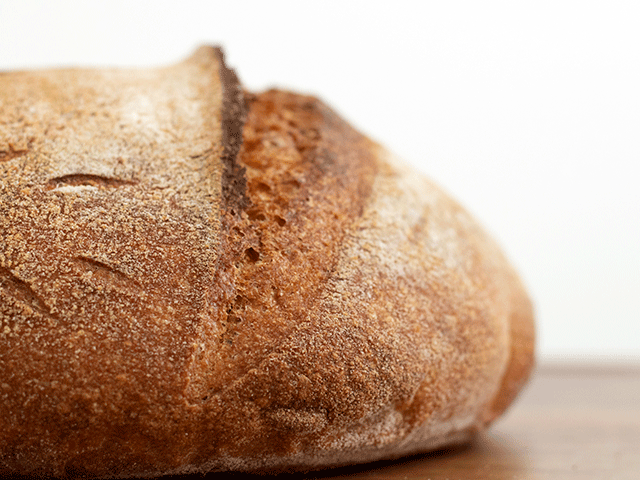
In a rush? You can skip straight to the 100% Whole Wheat Sourdough Bread Recipe at my Tumblr. Or you can jump to my Just the Basics section.
Ever since I purchased my wheat grinder, I’ve been excited at the idea of making a whole wheat artisan-style bread.
But for some reason, 100% whole wheat sourdough bread recipes are hard to find.
Many of them recommend combining whole wheat with all-purpose flour to make it easier to work with. Other recipes recommend sifting the whole wheat and removing the bran to make it less dense.
So I decided to go ahead and make my own recipe.

I Made This Recipe for You
I have to admit, my 100% whole wheat sourdough bread recipe has taken me more than a year to perfect. I’ve tried multiple variations of it to get it just right. I’ve changed timings, adjusted proportions, and experimented with techniques.
And even now, I’m not quite sure I have it exactly where I want it.
There’s always room for growth and improvement here. But I do have to say that I’m happy with this particular loaf. And I hope you can enjoy it as much as I do.

The Perfect Texture and Flavor
The crumb in this loaf is a nice blend. Not too holey that you can’t have a sandwich. But not dense like many other whole wheat recipes.
And because of the long rise times, I get an amazing wholesome flavor that has me drooling thinking about it.
I know 100% whole wheat sourdough bread may seem difficult at a glance, but don’t let that stop you from trying a new thing. It might just surprise you that you, too, can make great bread.
Time
Prep time: 30 to 40 Minutes
Rise time: 48 Hours
Cook time: 45 Minutes
Total time: 2+ Days
Ingredients
100% Whole Wheat Sourdough Bread doesn’t need a lot. In fact, it’s one of the simplest breads you can make if you have the time:
Levain
- 2 Grams (1/2 Teaspoon) Sourdough Starter
- 18 Grams (1 Tablespoon and 1 Teaspoon) Whole Wheat Flour
- 20 Grams (1 Tablespoon and 1 Teaspoon) Water
Dough
- 500 Grams (3 3/4 Cups) Whole Wheat Bread Flour*
- 475 Grams (2 Cups) Water
- 13 Grams (2 Teaspoons) Fine Sea Salt
If you don’t have whole wheat bread flour, you can make a substitute with vital wheat gluten:
- 472 Grams (3 1/2 Cups and 1 Tablespoon) Whole Wheat Flour
- 28 Grams (3 Tablespoons and 1 Teaspoon) Vital Wheat Gluten
I strongly encourage you to use either bread flour or vital wheat gluten when working with whole wheat. The extra protein helps hold your bread together and ensures your bread keeps its shape during baking. Without the gluten, your bread will likely fall flat.
Want to Scale the Recipe?
Here are the baker’s percentages:
- 95% Hydration
- 2% Salt
- 1% Levain
Easy to remember, right?
Additional Equipment
For this 100% whole wheat sourdough bread, you will need to have a few specialized tools to make this bread.
- Kitchen Scale
- Container With Lid
- Bench Scraper/ Dough Cutter
- Banneton Basket
- High-Heat Parchment Paper
- Bread Lame
- Dutch Oven
- Wire Cooling Rack
- High-Heat Oven Mitts
Although I link to items on Amazon, you don’t have to purchase them from here. You can find a lot of these items at Walmart or Costco, so keep an eye out for them. You might find better deals elsewhere.
If you do decide to purchase from an affiliate link, keep in mind that I earn a small commission from Amazon as an Amazon associate. Your engagement supports my site and keeps it running.
Instructions
100% Whole Wheat Sourdough Bread takes a lot of time to make. Although there are some areas where you can adjust it to meet your schedule, you’ll need to set aside several days for this recipe.
I’ll break down my basic timing for you, so you can get a general idea of how you can make this at home.
Day 1 – Feed Your Starter and Make Levain
I confess that my starter isn’t as active as some professional bakers. I prefer not to discard my starter daily to minimize waste. With many sourdough sandwich bread recipes, it doesn’t matter if my starter is sluggish as the starter is only used to add flavor.
But with 100% whole wheat sourdough bread, you need to have an active starter. The more active and bubbly, the better.
However, if your starter is sluggish like mine, I have a workaround that will give you beautiful bread. The key is to feed your starter first thing in the morning, and then make a levain in the evening.
10:30 AM – Feed Your Starter
I feed my starter at the same time every day, about 10:30 AM. Consistent feedings ensure my starter peaks at about the same time every day, making it easier to predict the best time to bake.
I maintain a whole wheat starter fed to 100% hydration. This means I measure out 40 grams whole wheat flour and 40 grams water and mix it into my starter.
10:30 PM – Make Levain and Autolyse Flour
Since my starter tends to be a bit slow, I make a levain with it the night before I mix my dough. Making a levain requires mixing a small amount of starter and giving it a bit extra food, so you have extra bubbles and activity by morning.
Simply combine your starter, water, and flour in a container with a lid. Close it and let it sit at room temperature over night.
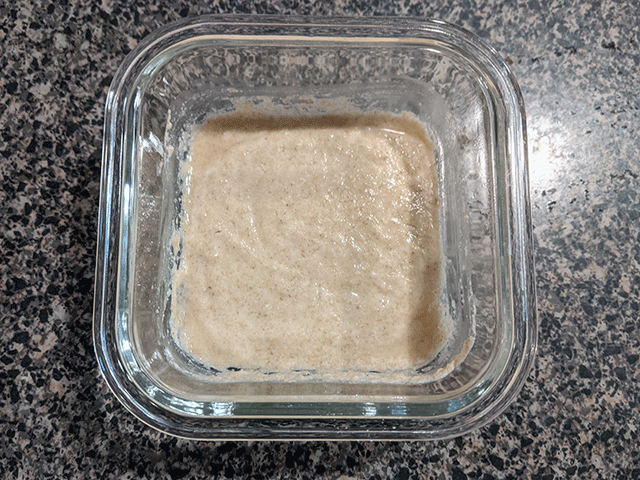
Also, since we’re dealing with whole wheat flour, we’re going to want a long autolyse time. The extra time gives your flour more opportunity to soak up the water and soften the bran.
After you’ve made your levain, you should combine your flour and water in a separate container with a lid. Let your sealed container also sit at room temperature overnight.

And just as a heads up, my kitchen tends to sit between 68 and 70 degrees Fahrenheit (20 to 21 degrees Celsius). If your kitchen is colder or warmer than mine, you’ll need to adjust your times to compensate when you make your 100% whole wheat sourdough bread.
Day 2 – Mix, Fold, and Shape
By the following morning, your levain should be nice and bubbly and your flour should have soaked up quite a bit of the water. It’s fine if your flour has a thin layer of water on top – you’ll be mixing everything together soon and the rest of the water will get mixed in with it.
10:30 AM – Mix Levain With Flour
Pour your levain over the top of your flour mixture. Wet your hands and fold the dough around the levain, squishing and pinching as you go to ensure the levain gets evenly distributed throughout the dough. It’s okay if your dough doesn’t have any shape at this point, so long as everything is mixed together.
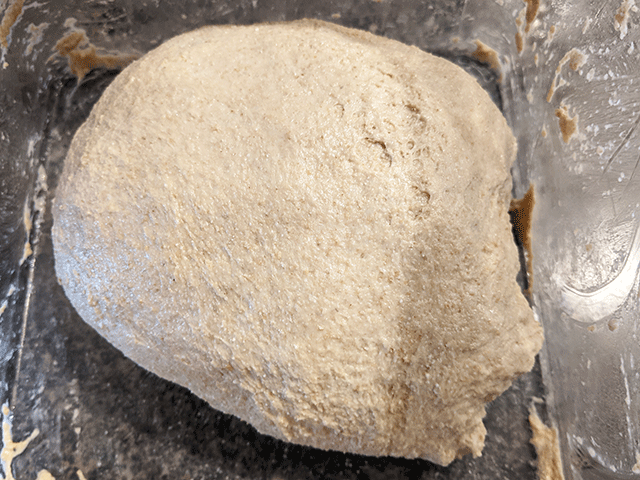
Remember that this is a high hydration dough – so the dough will be wet and sticky. Don’t worry. This is normal. If the dough keeps sticking to your hands, just wet them with a little water as your work.
After mixing, cover your dough and let it sit for 30 minutes.
11:00 AM – Add Salt
Once your dough has rested, you can add the sea salt. Sprinkle the salt over the dough, and then fold the dough around the salt. As with mixing the levain, you’ll want to pinch and squish and stretch your dough to ensure you fully work in the salt.
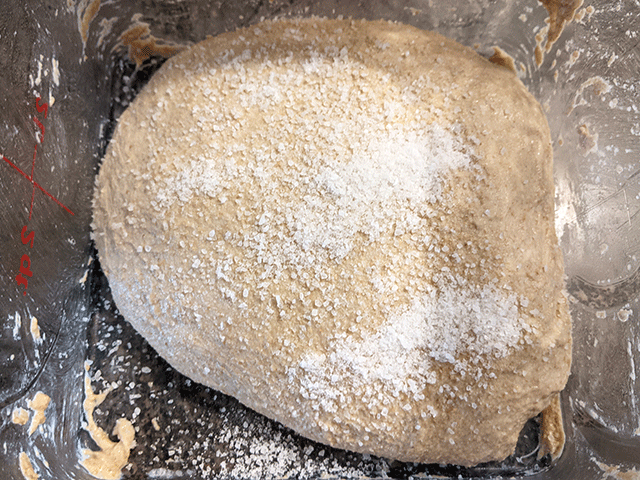
Don’t forget to wet your hands as you go. The water helps dissolve the salt so it distributes evenly, and the water keeps the dough from sticking to your hands.
Cover and let rest for 30 minutes.
11:30 AM – 1:00 PM – Stretch and Fold the Dough
Rather than kneading your dough, you’ll need to stretch and fold your dough to build up gluten and strengthen your dough. The more your stretch and fold your dough, the more your dough will start behaving more like dough and less like a gloopy mess.
Start by grabbing a corner of your dough, and pull it up toward you. Stretch it until you feel some resistance, but don’t intentionally break your dough.

Then fold that dough over the top of the rest.
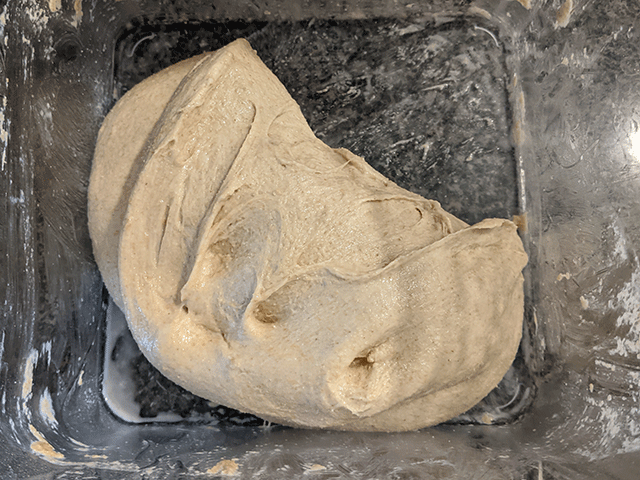
Grab another corner of your dough, stretch it up, and then fold it over. You’ll want to repeat this several times until your dough starts to take some shape and look a little like a round.
Let your dough rest for 30 minutes.
After resting, your dough will be ready to stretch and fold again. You’ll need to perform a total of 4 stretch-and-fold sessions over the course of 2 hours, with 30 minute breaks in between. It’s fine if you let your dough rest a bit longer if you’re busy, but try not to extend it too long so your dough has plenty of time to ferment uninterrupted later.
1:00 PM – 6:45 PM – Bulk Fermentation
Here’s my favorite part of making 100% whole wheat sourdough bread: bulk fermentation. You can simply let your dough sit for a few hours at room temperature. That’s it.

While your dough sits, it’s working its magic. The starter will be eating through the starches in your dough and creating nice gas pockets that will give your bread a light, airy texture in your bake.
6:45 PM – Pre-Shape the Dough
After a few hours, your dough will be ready to shape. If you look at the dough, you’d see you have some bubbles throughout and the dough will jiggle a bit when you shake it.
The next part of making 100% whole wheat sourdough bread, however, is a bit tricky. Even though I’ve practiced a lot, I still struggle to shape my dough properly.
But don’t worry – you can do this!
Turn out your dough onto a clean surface. And grab your bench scraper or dough cutter. Slide your bench scraper under your dough.
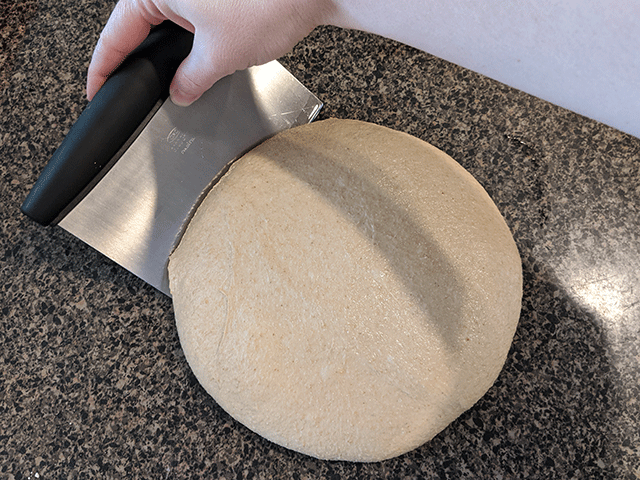
Now, turn your scraper like you would turn a steering wheel. As you turn, push inward on the dough. You want to build tension on the outside of the dough without breaking the skin.

Repeat sliding, turning, and pushing on the outer edges of the dough. Once you’ve made it all around the edges of your dough, you should have a nice dough round.

Cover your dough round and rest for 15 to 20 minutes. I overturn the container and use that to keep my round from drying out.
7:00 PM – Shape the Dough
After about 15 minutes, your dough round will have relaxed somewhat. Although it should still have a somewhat circular shape, it’ll flatten – and that’s fine.
Now you just repeat the same technique you used to pre-shape your dough. Slide, turn, and push around the edges to give your round its shape and build some tension in the dough.
The tighter your round, the better your oven spring will be.

When you’ve finished shaping your dough, slide your bench scraper completely under your dough round and use it to transfer your round, seam side up, into a floured banneton basket.
If your dough still seems a bit floppy and loose, you can try to stitch up your round. Wet your fingers and pinch the edges of your dough together.

You should note that this stitching technique works best with batards (long loaves) rather than boules (round loaves). But I find it’s the easiest way for me to build some tension when I struggle with my shaping.
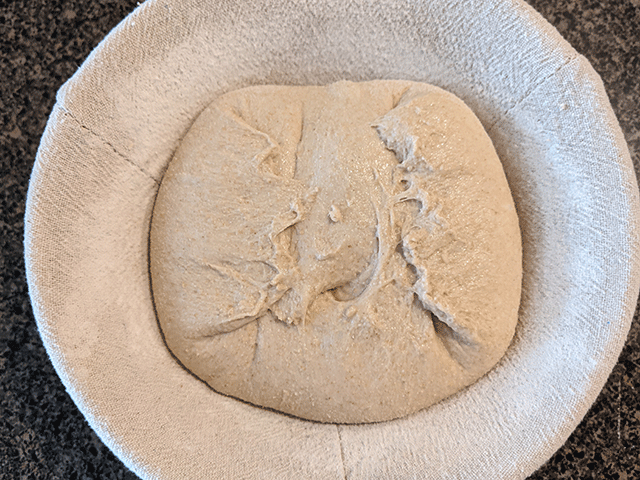
To ensure a rounder shape, rather than a long shape, I also fold over the edges and pinch them in. It’s not pretty, since I’m still learning, but it helps!
7:10 PM – Retard in the Fridge
After you’ve shaped your dough, it’s time to pop it in the fridge. I cover my loaf with Press and Seal wrap, but if you want a more environmentally friendly approach, I recommend opting for some reusable bowl covers.
Whatever you use, make sure it covers your dough enough that it won’t dry out in the fridge. A dried out round won’t rise properly in the fridge and won’t spring up in the oven.
You’ll also want to note your refrigerator temperature. My fridge is currently set to 40 degrees Fahrenheit (4 degrees Celsius). If you fridge is colder or warmer than mine, you’ll need to adjust your times to compensate. Colder temperatures require longer rise times.
Day 3 – Bake
Alright! You’re almost to the finish with this 100% whole wheat sourdough bread. You can do it!
If you were to take a peek at your dough right now, you may see that the stitching has relaxed somewhat in the dough. Your dough should have also risen a bit in the fridge, hopefully not beyond your banneton, but enough to be noticeable.
However, you’re not quite ready to bake just yet. First you need to preheat your Dutch oven and score your dough.
7:00 PM – Preheat the Oven and Dutch Oven
Do not bake your bread in a cold Dutch oven!
At least 45 minutes before you’re ready to bake, put your Dutch oven inside your oven and allow it to preheat to 475 degrees Fahrenheit (246 degrees Celsius). Preferably, let your Dutch oven preheat for at least an hour.
A thoroughly heated Dutch oven will keep your bread from sticking and will give it a better oven spring.
8:00 PM – Score Dough
Scoring the dough is important in artisan-style loaves. If your dough is under proofed, a deep slash can help open it up. Better still, good scoring prevents unwanted cracking and splitting in the top of your loaf and it gives your loaf a unique, artistic look.
To start, uncover your dough and turn it out onto a piece of high-heat parchment paper.
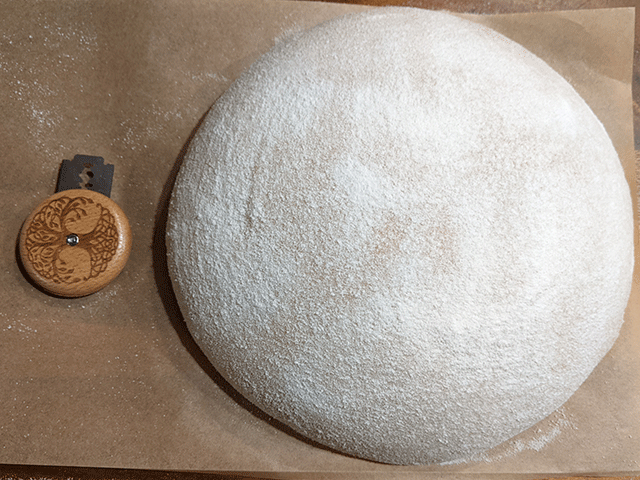
You’ll need to make at least one deep slash in your loaf to allow the gas to escape during baking. If you hold your razor or bread lame at a 30-degree angle, you can give your bread that oh-so-beautiful bread ear that bakers love.
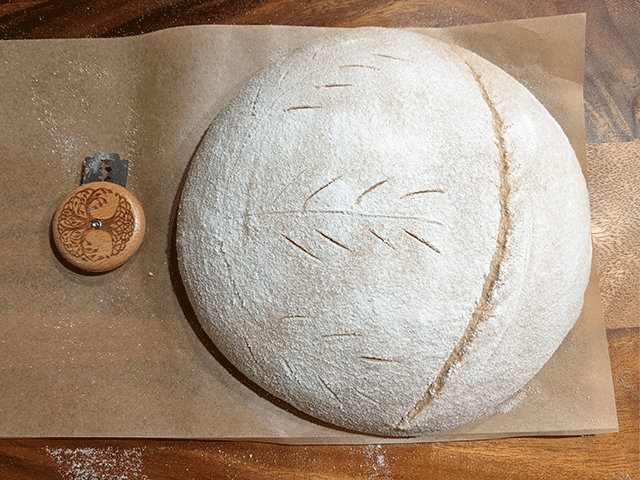
After your initial deep slash, you can decide how to score your bread from there. You could just keep things simple with your single slash, or you could express your creativity and make more intricate patterns.
Just remember that more delicate patterns require a lighter touch – only cut deep enough to break the skin. Deeper cuts result in wider splits.
8:05 PM – Bake and Cool
Once you’re oven has preheated and your dough has been scored, you’re ready to bake!
Carefully and quickly remove your Dutch oven from your oven and remove the lid. Use the parchment paper to transfer the dough to the Dutch oven.
Add an ice cube for a little extra steam and quickly cover the Dutch oven with the lid to capture the steam. Place the Dutch oven back in the oven and bake for 30 minutes at 475 degrees Fahrenheit (246 degrees Celsius).
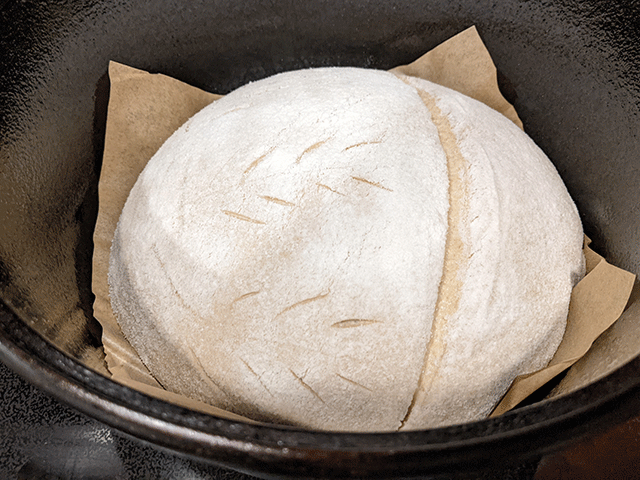
After 30 minutes total of baking time, remove the lid of your Dutch oven. Your bread won’t be done baking, but it should have sprung up quite nicely at this point.
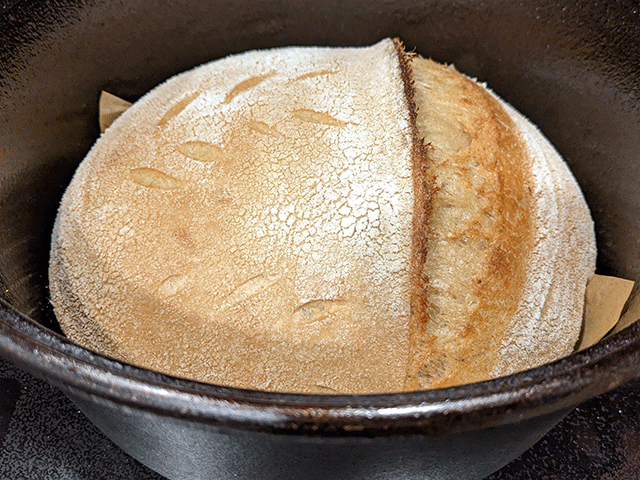
Lower the heat to 450 degrees Fahrenheit (232 degrees Celsius), continue baking without the lid for another 15 minutes. Your crust will darken and crisp up. You want to cook it until it’s just shy of being burnt for maximum flavor and caramelization in the crust.
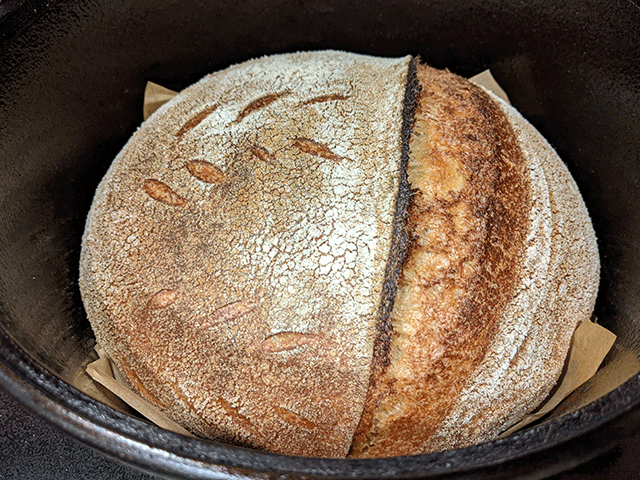
Don’t Cut Your Loaf Just Yet!
Turn your bread out onto a wire cooling rack and let it cool completely. Although it’s tempting to cut into your loaf now, please don’t do it. Your bread might be out of the oven, but it’s not done baking! It will continue to bake with its own residual heat.
If you cut into your bread too soon, your loaf will be spongey and gummy in the middle rather than soft. I suggest waiting at least an hour, preferably two or three before cutting into your bread.
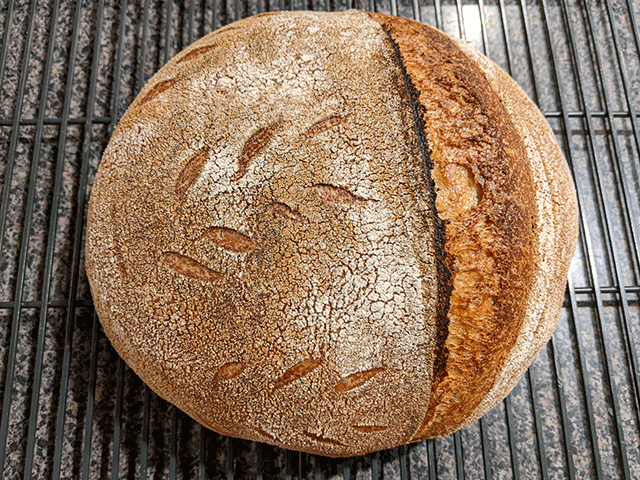
Once you’re bread has cooled, feel free to cut into it and enjoy!

Because this is sourdough bread, it can last a bit longer on the counter than other breads. Simply seal it in a bag and keep it at room temperature for about 5 days. Do not refrigerate your 100% whole wheat sourdough bread, as the colder temperatures will make the loaf go stale faster.
Just the Basics

100% Whole Wheat Sourdough Bread
Ingredients
Levain
- 2 Grams Sourdough Starter (1/2 Teaspoon)
- 18 Grams Whole Wheat Flour (1 Tablespoon and 1 Teaspoon)
- 20 Grams Warm Water (1 Tablespoon and 1 Teaspoon)
Dough
- 500 Grams Whole Wheat Bread Flour (3 3/4 Cups)
- 475 Grams Warm Water (2 Cups)
- 13 Grams Fine Sea Salt (2 Teaspoons)
Instructions
Day 1
- 10:30 AM – Feed your starter 40 grams whole wheat flour and 40 grams water.
- 10:30 PM – Make your levain and autolyse your flour.
Day 2
- 10:30 AM – Combine your levain and your flour. Let rest for 30 minutes.
- 11:00 AM – Add salt and mix well. Let rest for 30 minutes.
- 11:30 AM – 1 PM – Stretch and Fold dough 4 times with 30 minute breaks between each session.
- 1 PM – 6:45 PM – Bulk fermentation.
- 6:45 PM – Pre-shape dough. Let rest for 15 to 20 minutes.
- 7:00 PM – Shape dough. Cover and retard in the fridge.
Day 3
- 7:00 PM – Preheat Dutch oven inside the oven at 475° Fahrenheit (246° Celsius) for 45 minutes to an hour.
- 8:00 PM – Turn dough out onto parchment paper and score.
- 8:05 PM – Bake bread for 30 minutes.
- 8:35 PM – Lower heat to 450° Fahrenheit (246° Celsius). Remove lid and bake for 15 minutes.
- 8:50 PM – Turn bread out onto a wire cooling rack and allow to cool completely.
Day 4
- Slice and enjoy your bread!
Notes
Secrets to Success
Whole wheat flour is notoriously difficult to work with on its own. Most bakers recommend combining it with all-purpose flour to give it a lighter, airier texture and better oven spring.
To make this bread as light and fluffy as I could, I had to bump up the hydration by a LOT. Whereas many sourdough bread recipes I’ve tried keep hydration between 75% and 80% hydration, this loaf has a 95% hydration.
The higher the hydration, the more difficult the dough is to shape. If you are just starting out, you may have a hard time making 100% whole wheat sourdough bread picture perfect the first time around – and that’s okay!
The key is to practice, practice, practice! Eventually, you’ll get a feel for how the dough should look and feel as you work with it.
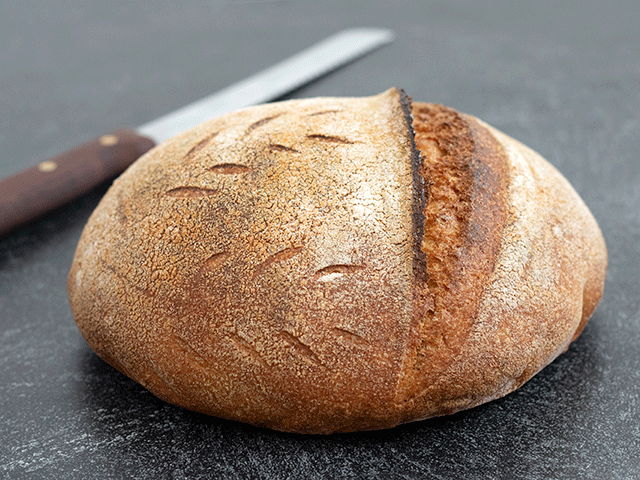
Trouble With Dough Sticking?
High hydration doughs tend to stick to everything. To minimize dough sticking to your bench scraper, work quickly as you shape. The longer you push into your dough, the more your dough will stick to the metal. If you need it, feel free to wet your scraper with water between pre-shaping and shaping your dough.
If your dough sticks to your banneton basket, use rice flour liberally. Rice flour sticks less than other flours and will brush off your dough later.
Do not use extra wheat flour on your surface when you turn out your dough. Although flour will help keep your dough from sticking, the flour will get folded into your dough as you work with it. That flour won’t blend or soak into the rest of your dough, and you’ll get powdery pockets of flour in your final bake.
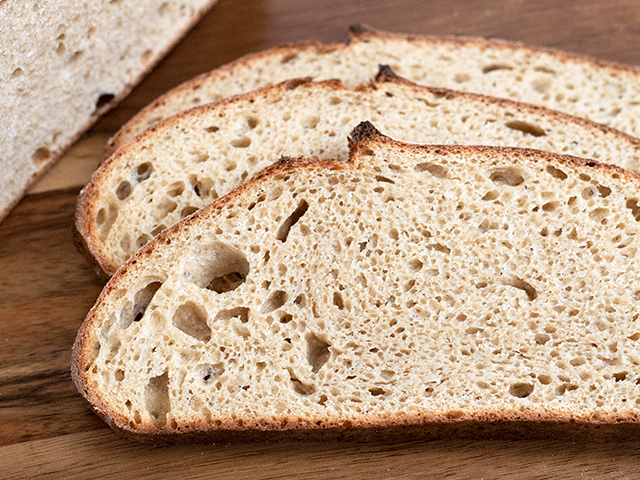
Take Notes When You Make Changes
You should also note that I made this recipe countless times before I could get it right. I adjusted the levain, the water, and the rise times to get the crumb I was looking for. I found that I needed long rise times and high hydration to get a more open crumb. But higher hydration often resulted in shorter rise times, so I had to cut the levain and increase the salt to slow things down.
Hopefully, I saved you some guesswork by adjusting everything, but you may need to make some adjustments of your own to best suit your schedule and the temperatures in your kitchen. Take notes as you bake!
If your 100% whole wheat sourdough bread seems like it can’t hold its shape as well as you’d like, then you may need to cut your rise time. If you want an even more open crumb, you may need to bump up the hydration even further and refrigerate your dough during bulk fermentation to extend your rise times beyond what I’ve listed here.
Once you’ve found a time that works best for you, let me know in the comments below! I love making good recipes even better.
Nutritional Information
My 100% whole wheat sourdough bread is high in fiber, and it doesn’t have any additional ingredients like sugar, butter, or milk that would add to the calorie count. As a result, it’s a healthy bread overall:
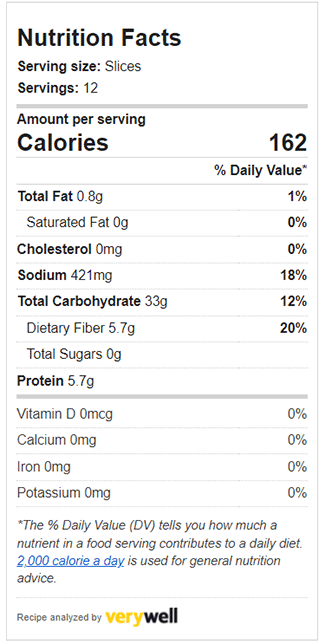
Of course, I shaped my bread into a boule, which means my slices are going to be bigger in the middle and smaller on the end. My calories per serving are going to vary from slice to slice, and yours likely will, too.
Did You Try It?
I know this recipe is a long and difficult one, but it’s definitely worth trying, especially if you like whole wheat bread. If you do end up trying it, or if you have some suggestions for improving this recipe, let me know in the comments below! I’d love to make the ultimate 100% whole wheat sourdough bread recipe, and with your help, I can.

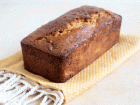
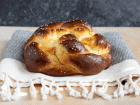

This was an easy recipe to follow. I’m still getting my feet wet with sourdough, though. It looked beautiful coming out of the oven, but it didn’t have a great crumb but the ear was gorgeous. It was more heavy and dense. I’m thinking that my kitchen was a lot cooler than yours and I didn’t let it ferment long enough.
I’m going to try it again, but how warm is too warm for a kitchen to be? I’ve got a seed starting station with a mat warmer I could use, but then again, it might get too hot.
Thank you so much for trying my recipe 🙂 If you’re looking for an open crumb, a long slow fermentation is key. If your kitchen is warm, it will cut the fermentation time and not give you the lighter airy crumb you want. When I made the recipe, my kitchen averaged about 68 degrees and my fridge was about 40 degrees. If you have a colder kitchen, you will need to extend your fermentation time. Take notes as you play around with the temperatures and let me know what worked best for you.
Good recipe! I’m trying my third bake tomorrow. The overnight autolyse seems really important. First whole wheat loaf I made didn’t have that good oven rise and I did a shorter autolyse. Second loaf I think I overproofed at room temp, and the dough overstretched and I think I lost some good gluten. Third time’s the charm hopefully! Thanks for this!
Oh thank you so much for sharing your experience! Good luck with your next loaf 🙂 You are most welcome.
Do you know why the salt is added when you do, instead of mixing the salt in with either the initial flour or water? I notice all the sourdough recipes I have looked at do this.
I do know a little bit about that! Yeast needs water to thrive, and salt attracts and absorbs water. If you add salt too soon, it dries out and kills your yeast before it has a chance to thrive. When you wait 30 minutes or so, you give the yeast some time to get active and get to work eating the flour. The salt then slows the fermentation process but doesn’t kill it entirely.
Have been using essentially the same recipe and method for about five years. The only major difference is I do not add vital wheat gluten as I’ve found that quality whole wheat flour is strong enough on its own. Yes, hydration is key to getting the right texture. Also, to avoid any chance of sticking to the pot, put the loaf on a piece of parchment paper and lower it in. Before putting on the lid, drop ice cubes between paper and sides of pot. I use about six of them. BE CAREFUL! Cast iron at 475 deg. is unforgiving if you touch it even slightly.
Thank you so much for your feedback. That’s very good advice 🙂